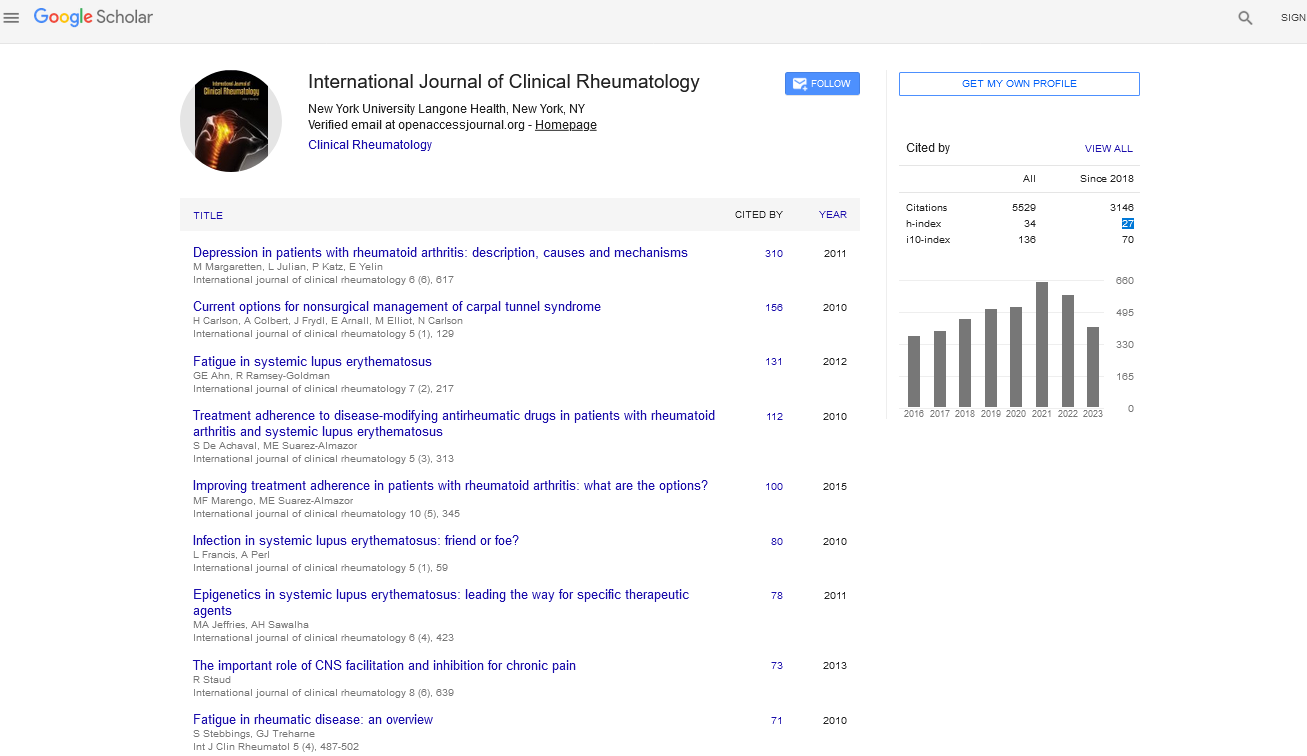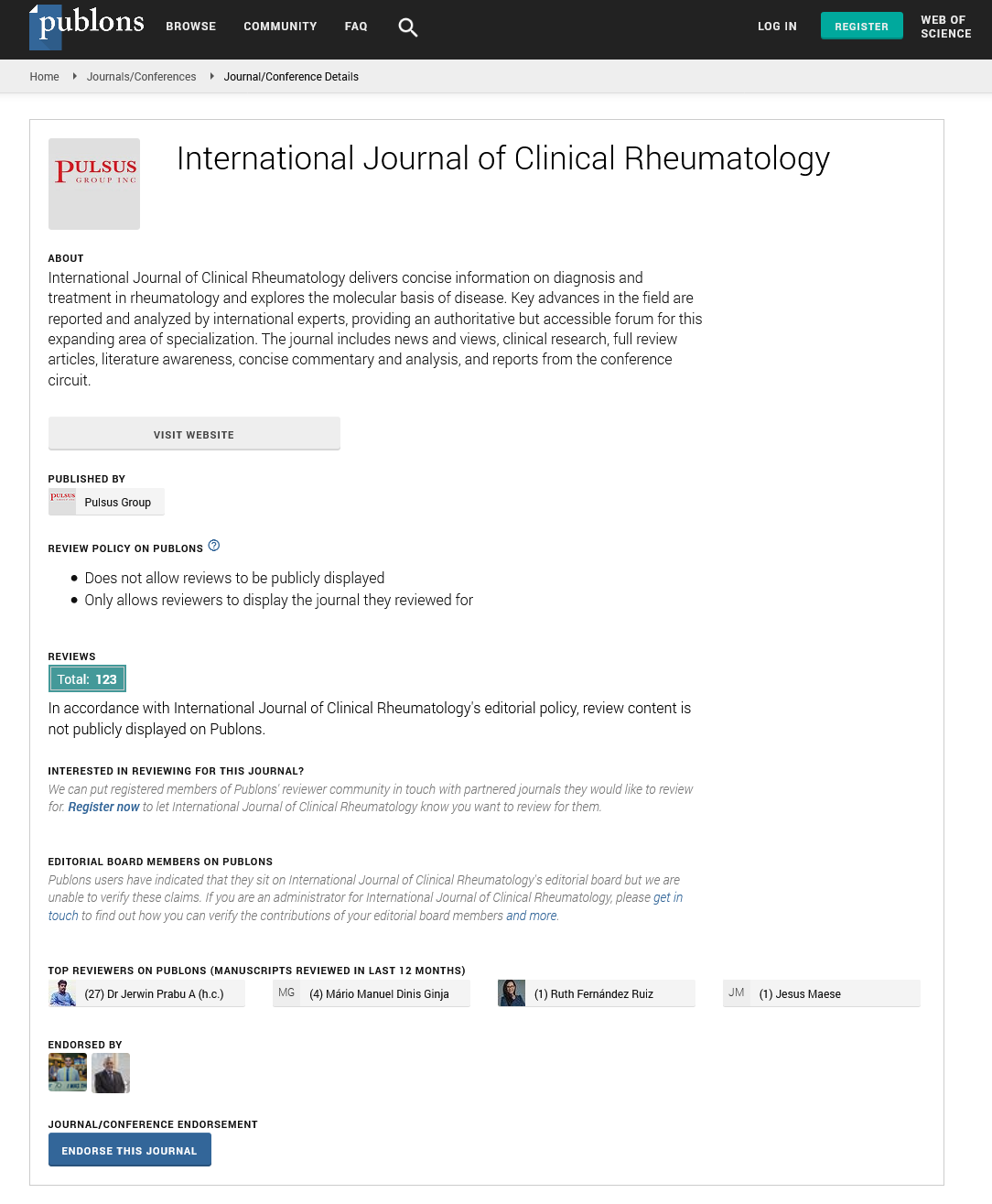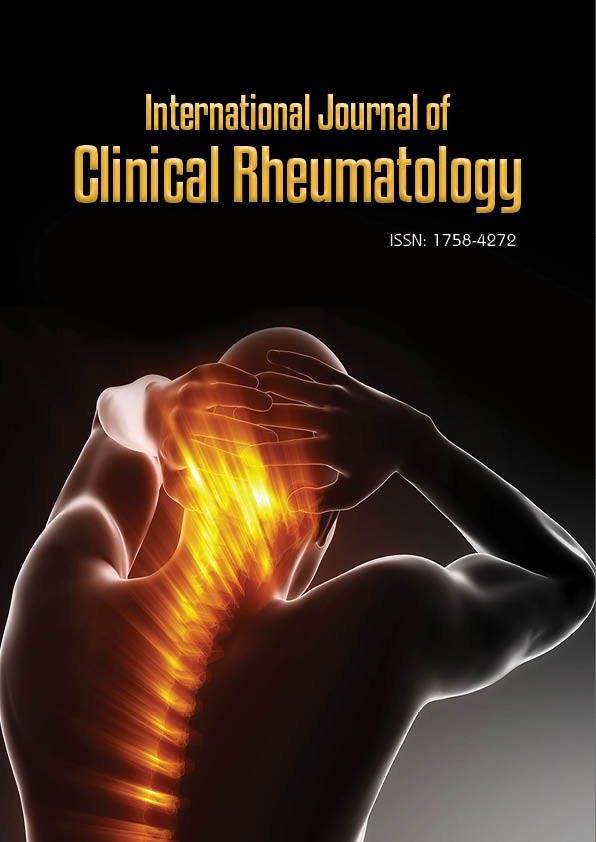Perspective - International Journal of Clinical Rheumatology (2024) Volume 19, Issue 12
New Insights and Approaches in Gout Management: A Comprehensive Overview
Ola M. Gharbia*
Institute of Rheumatology and Pharmaceutics, School of Pharmaceutical Sciences (Shenzhen), Yat-sen University, China
- *Corresponding Author:
- Ola M. Gharbia
Institute of Rheumatology and Pharmaceutics, School of Pharmaceutical Sciences (Shenzhen), Yat-sen University, China
E-mail: Gharbia_m@Ola.eg
Received: 02-Dec-2024, Manuscript No. fmijcr-25-159727; Editor assigned: 04- Dec-2024, Pre-QC No. fmijcr-25-159727 (PQ); Reviewed: 18-Dec-2024, QC No. fmijcr-25-159727; Revised: 23-Dec-2024, Manuscript No. fmijcr-25-159727 (R); Published: 30-Dec-2024, DOI: 10.37532/1758- 4272.2024.19(12).368-370
Abstract
Gout is a common and painful form of arthritis caused by the crystallization of monosodium urate (MSU) in the joints, resulting in acute inflammatory attacks. Over the years, significant strides have been made in understanding its underlying mechanisms, risk factors, and management strategies. This review provides an in-depth analysis of the most recent advancements in the understanding of gout, focusing on the molecular processes behind urate crystal formation, the genetic predispositions involved, and the influence of comorbid conditions. In addition, we explore current and emerging treatment options, such as novel urate-lowering therapies, biologic agents targeting inflammatory pathways, and strategies to prevent disease progression. The review also underscores the critical importance of personalized management plans, lifestyle modifications, and patient education in reducing flare frequency and long-term joint damage.
Keywords
Gout● Arthritis● Uricase
Introduction
Gout is a chronic and often painful form of arthritis that affects millions of individuals worldwide. It is characterized by the accumulation of urate crystals in joints, leading to inflammation and intense joint pain. This review article aims to provide an overview of recent advances in the understanding and management of gout. Gout, often referred to as the "disease of kings," has plagued humanity for centuries and remains a prevalent form of arthritis today. This excruciatingly painful condition is characterized by the buildup of urate crystals in joints, leading to acute attacks of inflammation and discomfort. Managing gout effectively is crucial to improve the quality of life for those who suffer from it [1]. In this article, we delve into the multifaceted world of gout management, exploring both traditional and contemporary strategies. Gout is a disease intricately linked to lifestyle choices, genetics, and underlying medical conditions, making its management a complex endeavor. Over the years, our understanding of gout's pathophysiology has deepened, enabling us to develop targeted interventions. From lifestyle modifications, such as dietary changes and alcohol restriction, to pharmacological therapies, including nonsteroidal antiinflammatory drugs (NSAIDs) and xanthine oxidase inhibitors, managing gout has evolved significantly. Moreover, we will explore emerging therapies and the potential of innovative biologics to revolutionize gout treatment. Join us on a journey through the art and science of managing gout, where we uncover the latest advancements in diagnosis, treatment, and prevention, offering hope and relief to those grappling with the challenges posed by this ancient yet modern ailment [2].
Pathophysiology of gout
Gout is primarily driven by hyperuricemia, a condition where there is an excessive buildup of uric acid in the blood. Uric acid is a byproduct of purine metabolism and is normally excreted by the kidneys. However, in individuals with gout, uric acid levels become elevated due to overproduction or reduced excretion. These high uric acid levels can lead to the formation of monosodium urate crystals in the joints and soft tissues, triggering an inflammatory response. Recent research has shed light on the intricate mechanisms underlying gout pathophysiology. Genetic factors, lifestyle choices, and comorbidities such as obesity and metabolic syndrome contribute to the development of hyperuricemia. Additionally, the role of the NLRP3 inflammasome, a key mediator of inflammation, has been implicated in gout attacks. Understanding these molecular pathways is crucial for developing targeted therapies [3, 4].
Diagnostic advancements
Accurate diagnosis of gout is essential for effective management. Traditionally, diagnosis relied on the presence of urate crystals in synovial fluid obtained through joint aspiration. However, recent advances in imaging techniques, such as dual-energy computed tomography (DECT) and ultrasound, have enabled non-invasive visualization of urate crystals in joints and soft tissues. These tools have improved diagnostic accuracy and allow for earlier intervention [5-7].
Treatment strategies
The management of gout involves both acute and long-term strategies. For acute gout attacks, nonsteroidal anti-inflammatory drugs (NSAIDs), colchicine, and corticosteroids are commonly prescribed to relieve pain and inflammation. In recent years, the use of interleukin-1 inhibitors, like anakinra, has shown promise in refractory cases. Long-term management aims to reduce uric acid levels in the blood to prevent future attacks and joint damage. This can be achieved through lifestyle modifications, including dietary changes to limit purine-rich foods and alcohol consumption. Pharmacological interventions, such as xanthine oxidase inhibitors (e.g., allopurinol and febuxostat), and uricosuric agents (e.g., probenecid) are prescribed to lower uric acid production and increase excretion [8, 9].
Emerging therapies
Recent research has led to the development of novel therapies for gout. One notable example is pegloticase, a recombinant uricase enzyme that breaks down uric acid. It is indicated for refractory gout and has shown promising results in lowering uric acid levels. Furthermore, research into targeted biologics, such as monoclonal antibodies against interleukin-1β and interleukin-6, is ongoing. These therapies have the potential to provide more precise and effective management of gout, particularly in cases where conventional treatments are ineffective or poorly tolerated [10].
Conclusion
In conclusion, gout is a complex and debilitating condition, but recent advances in our understanding of its pathophysiology and innovative diagnostic and treatment options have provided new hope for individuals suffering from this disease. Early diagnosis, lifestyle modifications, and pharmacological interventions are key components of gout management. Emerging therapies and a deeper understanding of the molecular mechanisms involved in gout offer the prospect of improved outcomes and a higher quality of life for those affected by this condition. Patients and healthcare providers alike should stay informed about these developments to ensure the best possible care for individuals with gout. In conclusion, the management of gout has evolved significantly in recent years, offering patients better control over their symptoms and improved quality of life. A multifaceted approach that combines lifestyle modifications, acute attack management, and long-term uric acid control is essential in effectively managing this complex condition. Dietary changes to reduce purine-rich foods and alcohol consumption play a pivotal role in preventing gout attacks. Maintaining a healthy weight and staying hydrated are also crucial. Patient education is essential in promoting these lifestyle changes. For those suffering from acute gout attacks, there are several effective medications available, including NSAIDs, colchicine, and corticosteroids. Early intervention can help alleviate pain and inflammation, reducing the duration and severity of attacks. The cornerstone of gout management is lowering uric acid levels in the blood. Xanthine oxidase inhibitors and uricosuric agents are commonly prescribed for this purpose. Regular monitoring of uric acid levels is vital to assess treatment efficacy and adjust medications as needed. Promising new therapies, such as pegloticase and targeted biologics, offer hope for individuals with refractory gout. These treatments may provide better outcomes for those who have not responded well to conventional approaches. In summary, the comprehensive management of gout requires a partnership between patients and healthcare providers. By embracing lifestyle modifications and staying informed about the latest advances in gout treatment, individuals with gout can minimize the frequency and severity of attacks, reduce joint damage, and enjoy a better quality of life.
References
- Thorn, Caroline F. Doxorubicin Pathways: Pharmacodynamics and Adverse Effects. Pharmacogenet Genomics. 21, 440-446 (2011).
- Brunelli D, Polonelli T, Benini L. Ultra-low energy pest detection for smart agriculture. IEEE Sens J. 1-4 (2020).
- Crippen TL, Poole TL.Conjugative transfer of plasmid-located antibiotic resistance genes within the gastrointestinal tract of lesser mealworm larvae,Alphitobius diaperinius(Coleoptera: Tenebrionidae). Foodborne Pathog Dis. 7, 907-915 (2009).
- Dwyer, Claire. ‘Highway to Heaven’: the creation of a multicultural, religious landscape in suburban Richmond, British Columbia. Soc Cult Geogr. 17, 667-693 (2016).
- Südfeld S.Post-induction hypotension and early intraoperative hypotension associated with general anaesthesia. Br J Anaesth. 81, 525-530 (2017).
- Makam AN, Nguyen OK. An Evidence-Based Medicine Approach to Antihyperglycemic Therapy in Diabetes Mellitus to Overcome Overtreatment. Circulation. 135, 180-195 (2017).
- Chandalia M, Lutjohann D, von Bergmann K et al. Beneficial effects of high dietary fiber intake in patients with type 2 diabetes mellitus. N Engl J Med. 342, 1392-8 (2000).
- Gething MJ. Role and regulation of the ER chaperone BiP. Seminars in Cell and Developmental Biology. 10, 465-472 (1999).
- Schepers E, Meert N, Glorieux G et al. P-cresylsulphate, the main in vivo metabolite of p-cresol, activates leucocyte free radical production. Nephrol Dial Transplant. 22, 592-596 (2006).
- Ricci Z, Ronco C, Amico GD et al. Practice patterns in the management of acute renal failure in the critically ill patient: an international survey. Nephrol Dial Transplant. 21, 690-696 (2006).
Indexed at, Google Scholar, Crossref
Indexed at, Google Scholar, Crossref
Indexed at, Google Scholar, Crossref
Indexed at, Google Scholar, Crossref
Indexed at, Google Scholar, Crossref
Indexed at, Google Scholar, Crossref
Indexed at, Google Scholar, Crossref
Indexed at, Google Scholar, Crossref


